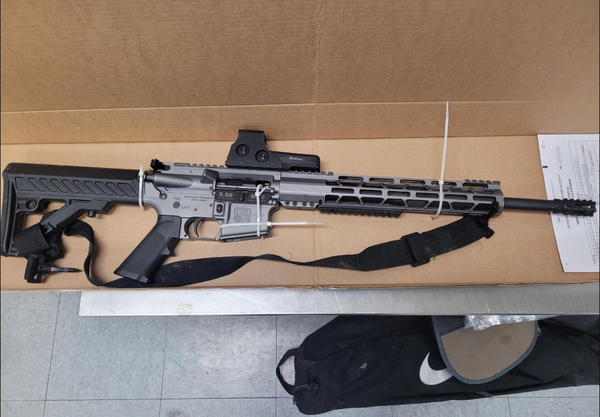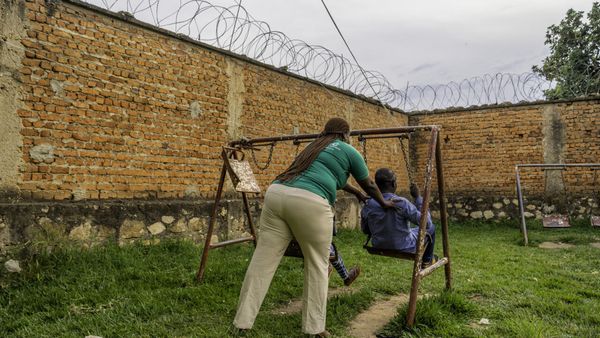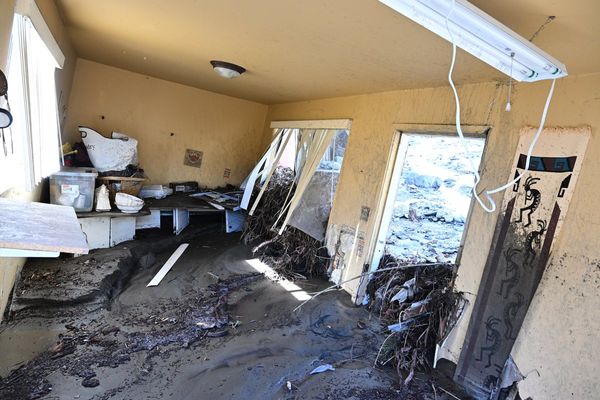
A $100,000 salary, once seen as a sign of tremendous financial success, doesn’t go as far these days. How far it goes varies widely depending on which state you live in.
Find Out: I’m an Economist — Here’s How Likely a Recession Is for the Second Half of 2025
Learn More: 5 Cities You Need To Consider If You're Retiring in 2025
In 13 states, a $100,000 salary isn’t even enough to cover average annual cost of living. On the other end of the spectrum, there are 15 states where making that amount would cover 120% or more of those expenditures.
GOBankingRates has generated a list of all 50 states, ranked by the percentage of annual expenditures $100,000 a year will cover. Data was sourced from the Bureau of Labor Statistics and the Missouri Economic Research and Information Center.
Here’s the full list, along with each state’s cost-of-living index (100 equals the national average), average annual expenditures and other related information.
Also see how far the median income goes in the largest American cities.

50. Oklahoma
- Cost-of-living index: 85.5
- Annual expenditures: $77,529
- % of annual expenditures that $100K covers: 129.0%
With the lowest cost-of-living index in the nation, Oklahoma leads the way in percentage of annual expenditures that $100,000 covers. The Sooner State trails only Arkansas for the lowest grocery score, with 95.7 on a scale with the median at 100. Transportation costs come in at 86.7 (lowest in the nation), and housing comes in at 70.5 (second lowest). Utilities (94.7) are only the 20th lowest, however.
Find Out: What Is the Estimated Median Income for the Upper-Middle Class in 2025?
See Next: Here’s the Minimum Net Worth To Be Considered Upper Class in Your 50s
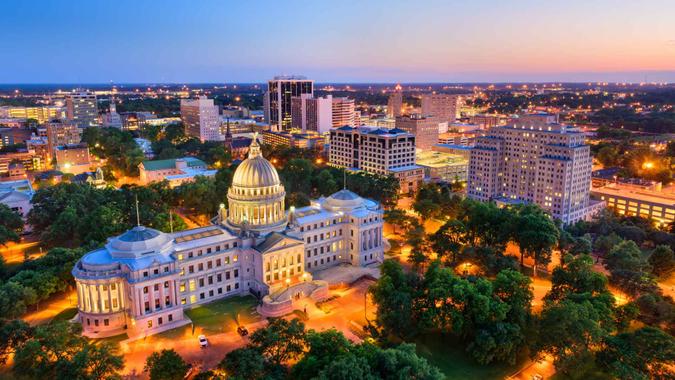
49. Mississippi
- Cost-of-living index: 87.3
- Annual expenditures: $79,161
- % of annual expenditures that $100K covers: 126.3%
Mississippi has the nation’s fourth-least expensive groceries. Housing costs are also the fourth lowest, with average annual costs around $12,200.
Discover More: What Salary Single People Need To Live Comfortably in 100 Major US Cities

48. Alabama
- Cost-of-living index: 87.6
- Annual expenditures: $79,433
- % of annual expenditures that $100K covers: 125.9%
Alabama has the nation’s lowest cost-of-living score for housing at 69.1. That translates into average monthly housing expenditures of $966.
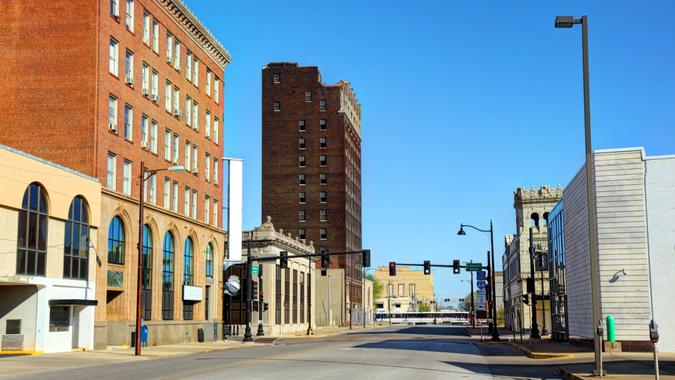
47. Missouri
- Cost-of-living index: 88.0
- Annual expenditures: $79,796
- % of annual expenditures that $100K covers: 125.3%
Missouri is closer to the middle of the pack on average utility costs at about $431 a month. The Show Me State is tied for the seventh-lowest grocery index (96.7) and has the sixth-least expensive housing (74.8), the second-least expensive transportation (87.2) and the ninth-least expensive housing (91.0).

46. West Virginia
- Cost-of-living index: 88.6
- Annual expenditures: $80,340
- % of annual expenditures that $100K covers: 124.5%
Monthly grocery expenditures in West Virginia are $568 on average, tied for seventh lowest in the country. Healthcare costs in the Mountain State are the nation’s 12th lowest, coming in at $592 a month.
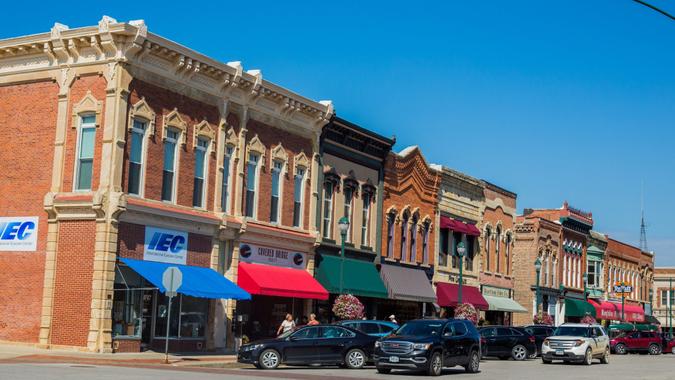
45. Iowa
- Cost-of-living index: 89.6
- Annual expenditures: $81,247
- % of annual expenditures that $100K covers: 123.1%
Iowa has the nation’s third-lowest cost-of-living score for groceries, with monthly expenditures of $562. The Hawkeye State has the 11th-lowest index for housing, 77.7.
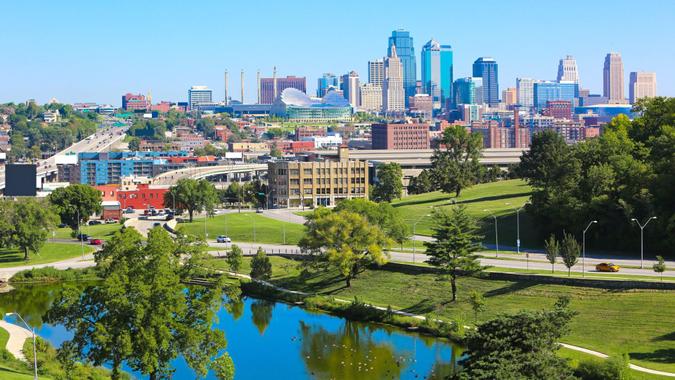
44. Kansas
- Cost-of-living index: 89.7
- Annual expenditures: $81,337
- % of annual expenditures that $100K covers: 122.9%
Kansas has the nation’s sixth-least expensive groceries, with average expenditures of $567 a month. Housing is the eighth-least expensive (75.6).
Check Out: Here’s the Minimum Salary Required To Be Considered Upper-Middle Class in 2025

43. Michigan
- Cost-of-living index: 89.8
- Annual expenditures: $81,428
- % of annual expenditures that $100K covers: 122.8%
For average grocery costs, Michigan sits in the middle of the pack with average monthly expenditures of $581. Housing is relatively inexpensive, though. Michigan’s housing index (73.9) is the nation’s fifth lowest.

42. Tennessee
- Cost-of-living index: 90.0
- Annual expenditures: $81,609
- % of annual expenditures that $100K covers: 122.5%
The Volunteer State is tied for the seventh lowest grocery expenditures in the nation, about $570 a month. Transportation costs are among the lowest in the country — $623 a month on average.
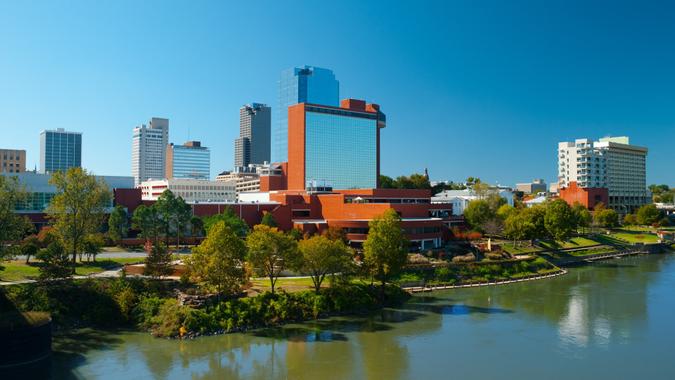
41. Arkansas
- Cost-of-living index: 90.5
- Annual expenditures: $82,063
- % of annual expenditures that $100K covers: 121.9%
You’ll find the nation’s least expensive groceries in Arkansas, with the state’s cost-of-living index coming in at 95.1. Average healthcare costs are the nation’s second lowest — a score of 85.4 that trails only Nevada.

40. Indiana
- Cost-of-living index: 90.8
- Annual expenditures: $82,335
- % of annual expenditures that $100K covers: 121.5%
The Hoosier State comes in just below the median for grocery costs, scoring a 98. Housing in Indiana comes in further below the median at 76.
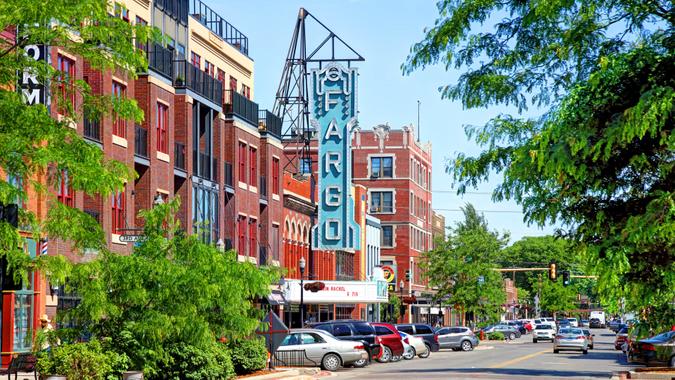
39. North Dakota
- Cost-of-living index: 90.8
- Annual expenditures: $82,335
- % of annual expenditures that $100K covers: 121.5%
Groceries in North Dakota will run you $571 a month on average, which equates to an index of 97.2. Housing is 10th least expensive with a score of 76.9.
Read Next: Salary Needed To Achieve the American Dream in the 50 Largest Cities
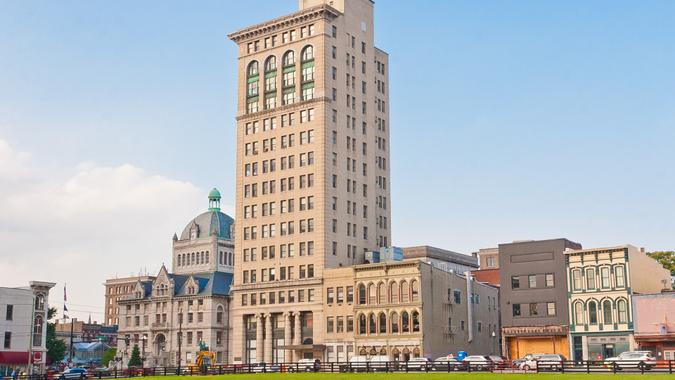
38. Kentucky
- Cost-of-living index: 91.7
- Annual expenditures: $83,151
- % of annual expenditures that $100K covers: 120.3%
Housing in Kentucky is the nation’s seventh-least expensive, scoring a 75. Monthly housing expenditures in the Bluegrass State come in at $1,048 on average.
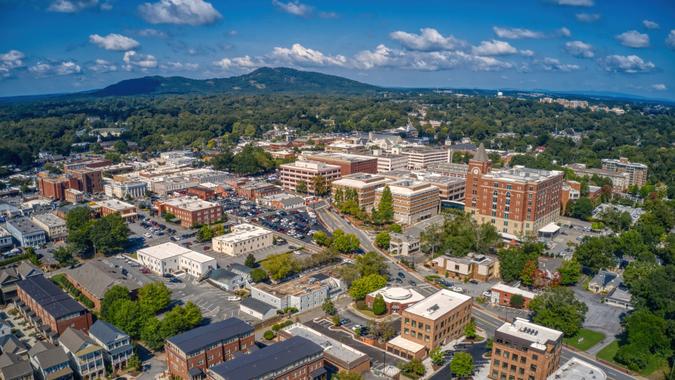
37. Georgia
- Cost-of-living index: 91.7
- Annual expenditures: $83,151
- % of annual expenditures that $100K covers: 120.3%
Utilities in Georgia are relatively expensive, with average monthly costs at $454 — 10th highest in the country. The Peach State ranks 14th lowest for groceries with a cost-of-living index of 97.7.

36. Texas
- Cost-of-living index: 91.8
- Annual expenditures: $83,241
- % of annual expenditures that $100K covers: 120.1%
Texas has the country’s fourth-least expensive grocery expenditures with a cost-of-living index of 95.8. Texans pay about $563 a month. Residents of the Longhorn State pay more than the national average for utilities — $457 each month on average.

35. Nebraska
- Cost-of-living index: 92.4
- Annual expenditures: $83,786
- % of annual expenditures that $100K covers: 119.4%
Housing expenditures in Nebraska come in around $13,185 annually, the 12th-lowest figure in the nation. Utilities and transportation are each the 14th lowest.
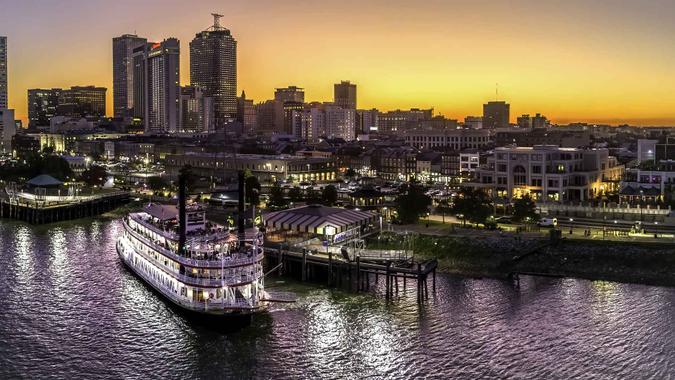
34. Louisiana
- Cost-of-living index: 93.2
- Annual expenditures: $84,511
- % of annual expenditures that $100K covers: 118.3%
Louisiana has the country’s third-lowest utilities expenditures, with residents paying $360 a month on average. The Bayou State has the seventh-lowest grocery expenditures and 18th-lowest housing expenditures.
Try This: 9 Things the Middle Class Should Consider Downsizing To Save on Monthly Expenses
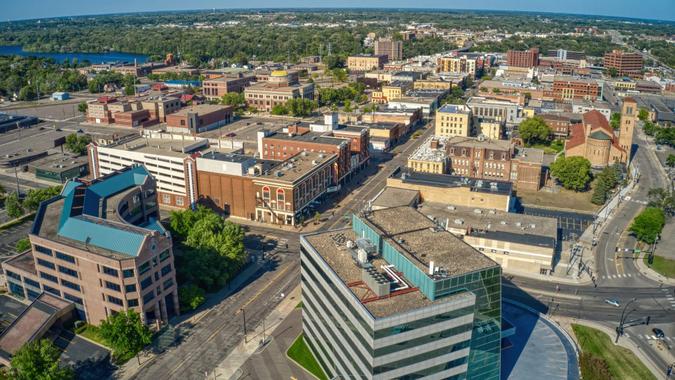
33. Minnesota
- Cost-of-living index: 93.7
- Annual expenditures: $84,964
- % of annual expenditures that $100K covers: 117.7%
Minnesota ranks 15th among states with the lowest housing expenditures. The Gopher States sits in the middle of the pack for grocery expenditures and other costs.
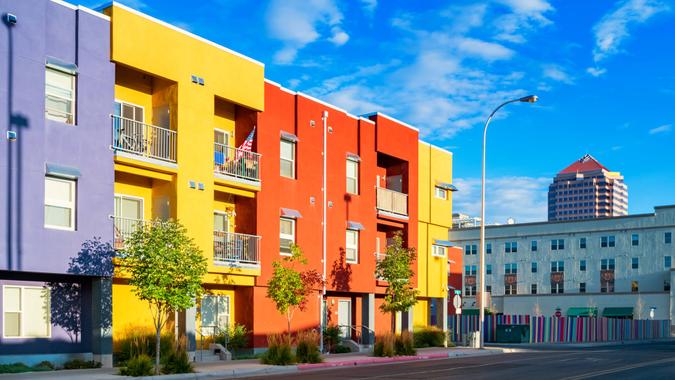
32. New Mexico
- Cost-of-living index: 94.2
- Annual expenditures: $85,418
- % of annual expenditures that $100K covers: 117.1%
New Mexico residents pay about 98% of the national median for groceries, about $575 each month on average. Housing costs sit in the middle of the pack, with a cost-of-living index of 90.2.

31. South Carolina
- Cost-of-living index: 94.6
- Annual expenditures: $85,780
- % of annual expenditures that $100K covers: 116.6%
Groceries in South Carolina cost $537 a month on average, which places the Palmetto State in the middle of the pack. Healthcare expenditures are the 15th lowest in the nation.

30. Illinois
- Cost-of-living index: 94.7
- Annual expenditures: $85,871
- % of annual expenditures that $100K covers: 116.5%
Average expenditures in Illinois rank in the middle of the pack across all categories. Groceries come in just below the national median, with average monthly costs sitting at $579.
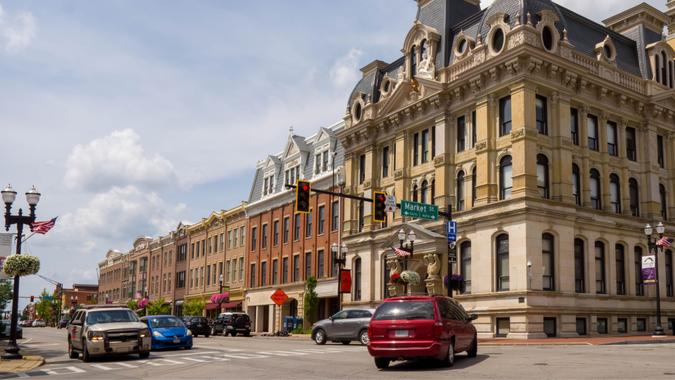
29. Ohio
- Cost-of-living index: 95.1
- Annual expenditures: $86,234
- % of annual expenditures that $100K covers: 116.0%
Ohioans pay just below the national median for groceries, with the Buckeye State’s cost-of-living score at 99.6. Ohio residents pay 86.7% of the national median for housing, which pencils out to an average of $1,212 a month.
Trending Now: How Much You Need To Earn To Be Upper Middle Class in Every State
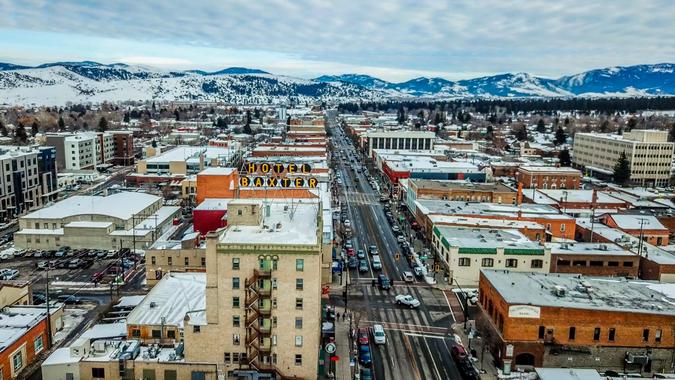
28. Montana
- Cost-of-living index: 96.4
- Annual expenditures: $87,413
- % of annual expenditures that $100K covers: 114.4%
Montana has the nation’s ninth-highest grocery expenditures. Utilities are the second-least expensive in the nation, trailing only Idaho.
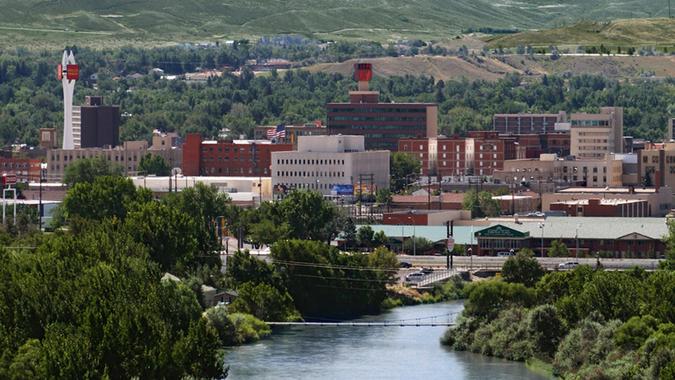
27. Wyoming
- Cost-of-living index: 97.0
- Annual expenditures: $87,957
- % of annual expenditures that $100K covers: 113.7%
Wyoming residents pay just over the national median for groceries, about $600 a month. Housing costs come in around $1,275 a month.
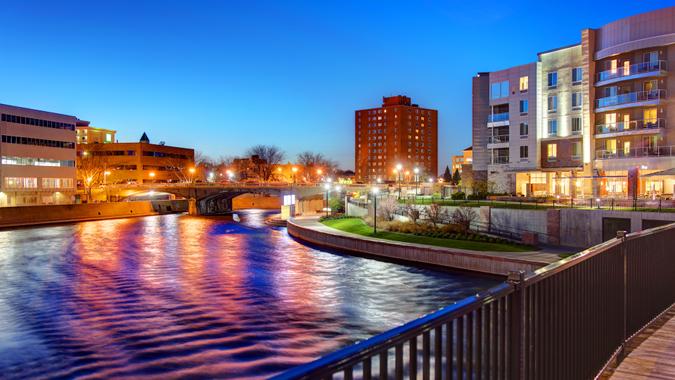
26. South Dakota
- Cost-of-living index: 97.3
- Annual expenditures: $88,229
- % of annual expenditures that $100K covers: 113.3%
South Dakota residents pay about 3.5% more than the national median for groceries — about $608 a month. South Dakota ranks right in the middle — 25th — on housing costs at $1,327 a month.
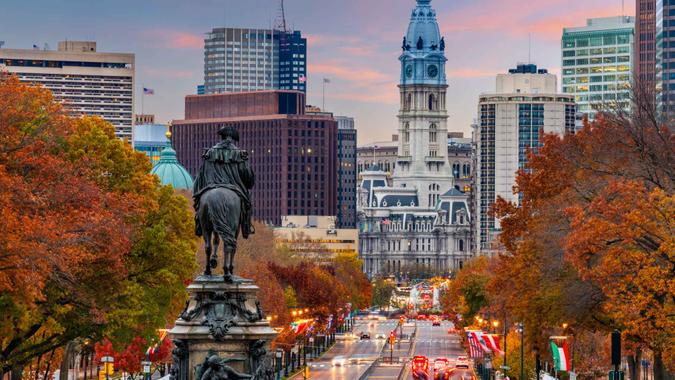
25. Pennsylvania
- Cost-of-living index: 97.5
- Annual expenditures: $88,410
- % of annual expenditures that $100K covers: 113.1%
The Keystone State has the nation’s 12 lowest grocery expenditures, scoring a 97.4. Utility expenditures are the 11th most expensive.
View Next: Here’s the Minimum Salary Required To Be Considered Upper Class in 2025

24. North Carolina
- Cost-of-living index: 97.8
- Annual expenditures: $88,682
- % of annual expenditures that $100K covers: 112.8%
North Carolina has the nation’s 10th-highest healthcare expenditures. The Tar Heel State scores below the national median in groceries (97.7), housing (94.9), utilities (94.7) and transportation (92.9).
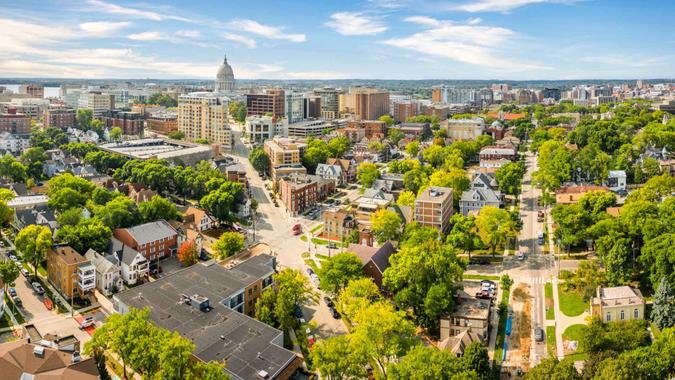
23. Wisconsin
- Cost-of-living index: 99.5
- Annual expenditures: $90,224
- % of annual expenditures that $100K covers: 110.8%
Wisconsin residents pay slightly below the national median for groceries, $585 on average. Housing is also just below the national median, with average expenditures of $16,725 a year.

22. Nevada
- Cost-of-living index: 99.5
- Annual expenditures: $90,224
- % of annual expenditures that $100K covers: 110.8%
Nevada residents have the lowest healthcare expenditures in the nation, paying about 85% of the national median. That translates into an average of $534 a month.

21. Utah
- Cost-of-living index: 100.5
- Annual expenditures: $91,130
- % of annual expenditures that $100K covers: 109.7%
Utah residents enjoy the fifth-lowest healthcare expenditures in the country. Utilities are also the fifth lowest.

20. Virginia
- Cost-of-living index: 101.4
- Annual expenditures: $91,946
- % of annual expenditures that $100K covers: 108.8%
Virginia’s average expenditures are mid-level compared to other states. The Old Dominion State does have the country’s 13th-lowest transportation expenditures.
Discover More: Warren Buffett’s Top 4 Tips for Getting Richer

19. Idaho
- Cost-of-living index: 102.0
- Annual expenditures: $92,491
- % of annual expenditures that $100K covers: 108.1%
Idahoans pay only about 74% of the national median for utilities — $327 each month on average. That’s the lowest in the nation. Transportation costs are the nation’s ninth highest.
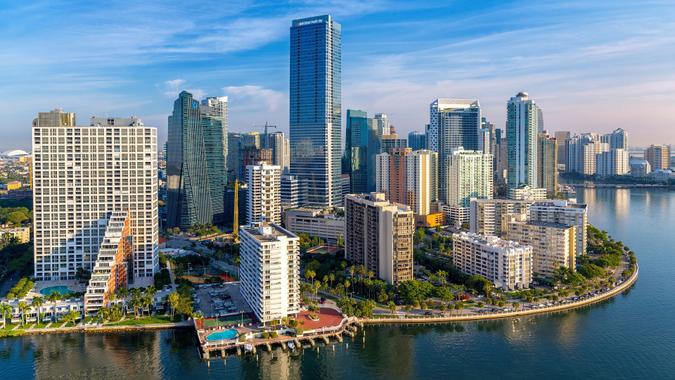
18. Florida
- Cost-of-living index: 102.0
- Annual expenditures: $92,491
- % of annual expenditures that $100K covers: 108.1%
Florida residents pay about 90% of the national median for healthcare. That’s the sixth-least expensive in the country.

17. Delaware
- Cost-of-living index: 103.5
- Annual expenditures: $93,851
- % of annual expenditures that $100K covers: 106.6%
Delaware has the nation’s 17th-highest healthcare expenditures, with residents paying nearly 7% more than the national median. The First State ranks in the middle of the pack in other expenditure categories.

16. Colorado
- Cost-of-living index: 104.0
- Annual expenditures: $94,304
- % of annual expenditures that $100K covers: 106.0%
Colorado scores a 102.6 on grocery expenditures compared to a national median of 100. That translates to $603 each month on average.
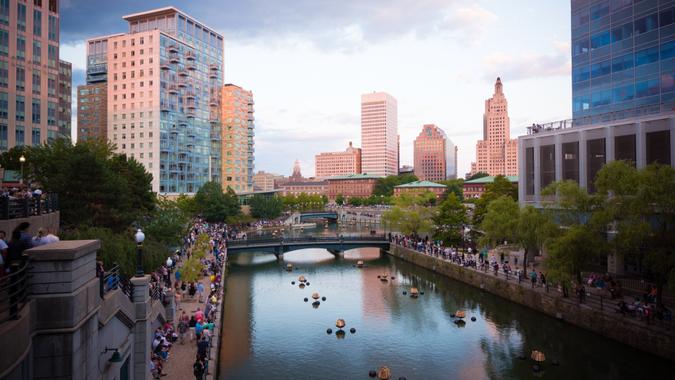
15. Rhode Island
- Cost-of-living index: 109.3
- Annual expenditures: $99,110
- % of annual expenditures that $100K covers: 101.0%
Utility expenditures in tiny Rhode Island are the fifth highest in the country. Rhode Island sits near the middle of the pack across other expenditure categories.
Be Aware: Mark Cuban Tells Americans To Stock Up on Consumables as Trump’s Tariffs Hit — Here’s What To Buy
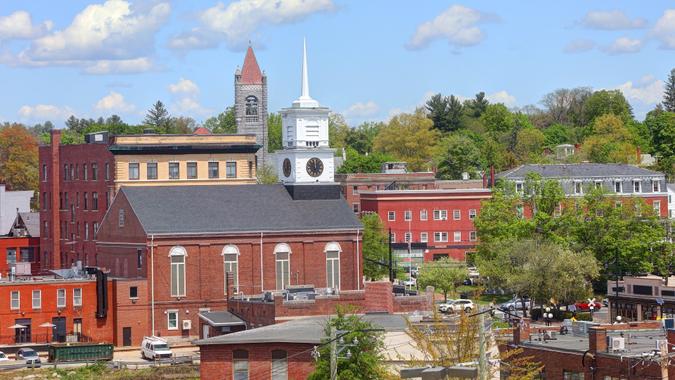
14. New Hampshire
- Cost-of-living index: 110.1
- Annual expenditures: $99,835
- % of annual expenditures that $100K covers: 100.2%
A $100,000 salary in New Hampshire will barely cover average annual expenditures. The Granite State has the nation’s 15th most expensive housing costs, with residents paying $1,624 each month on average.
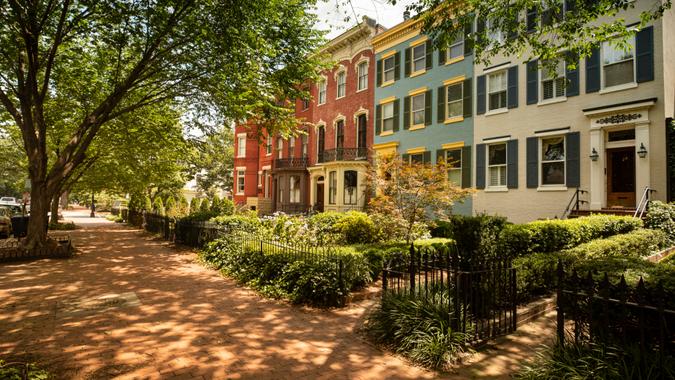
13. Washington
- Cost-of-living index: 112.0
- Annual expenditures: $101,558
- % of annual expenditures that $100K covers: 98.5%
Groceries in the Evergreen State come in about 8% higher than the national median, with monthly expenditures at $636 on average. Housing is the nation’s 14th highest.

12. Arizona
- Cost-of-living index: 112.5
- Annual expenditures: $102,012
- % of annual expenditures that $100K covers: 98.0%
Arizona’s cost-of-living index for housing comes in at 134.8. That ranks the Grand Canyon State seventh in the country for the most expensive housing.

11. Oregon
- Cost-of-living index: 112.7
- Annual expenditures: $102,193
- % of annual expenditures that $100K covers: 97.9%
Oregon has the nation’s seventh-most expensive groceries, 11th-most expensive housing, fifth-most expensive transportation and fifth-highest healthcare expenditures.

10. Maine
- Cost-of-living index: 113.4
- Annual expenditures: $102,828
- % of annual expenditures that $100K covers: 97.3%
Maine sits in the middle of the pack for grocery costs. But the Pine Tree State is relatively more expensive when it comes to housing, which is 33.2% higher than average — the country’s ninth highest index.
For You: The Living Wage a Family of 4 Needs in All 50 States
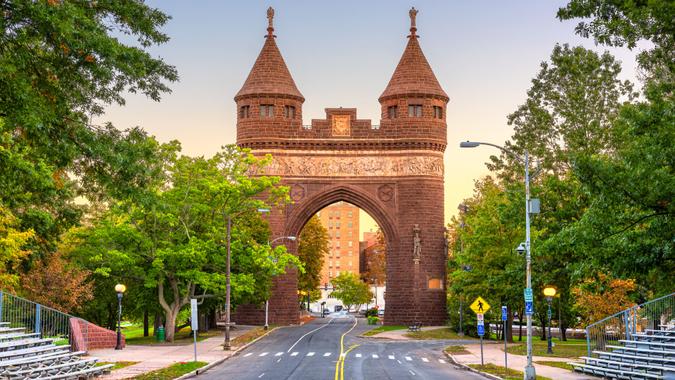
9. Connecticut
- Cost-of-living index: 113.5
- Annual expenditures: $102,918
- % of annual expenditures that $100K covers: 97.2%
Utilities are relatively expensive in Connecticut, with residents paying an average of $562 each month. That’s the fourth highest in the nation.

8. Vermont
- Cost-of-living index: 113.7
- Annual expenditures: $103,100
- % of annual expenditures that $100K covers: 97.0%
Vermont ranks in the top 12 for the most expensive groceries (fifth), housing (12th), utilities (ninth) and healthcare (eighth). Transportation costs are only the 19th-most expensive.

7. New Jersey
- Cost-of-living index: 114.8
- Annual expenditures: $104,097
- % of annual expenditures that $100K covers: 96.1%
New Jersey residents pay the sixth-highest average costs in the nation for housing – just over $2,000 a month. Healthcare is the 13th-most expensive.
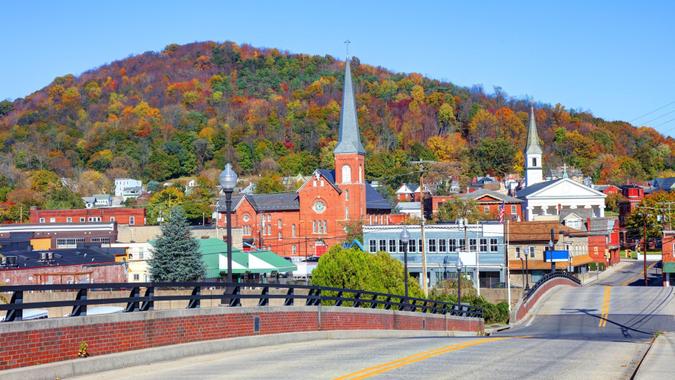
6. Maryland
- Cost-of-living index: 114.9
- Annual expenditures: $104,188
- % of annual expenditures that $100K covers: 96.0%
Maryland residents pay about 5% above the national median for groceries, which pencils out to $618 each month on average. Housing costs are the nation’s eighth priciest.
That’s Interesting: What Is the Estimated Median Income for the Upper-Middle Class in 2025?

5. New York
- Cost-of-living index: 124.7
- Annual expenditures: $113,074
- % of annual expenditures that $100K covers: 88.4%
The cost of living in the Empire State varies widely based on where you live. Overall, New York has the country’s fifth-highest housing costs, 12th most expensive groceries, seventh most expensive transportation costs, and 11th most expensive healthcare.

4. Alaska
- Cost-of-living index: 127.3
- Annual expenditures: $115,432
- % of annual expenditures that $100K covers: 86.6%
Alaska has the nation’s most expensive healthcare, with residents paying $891 a month on average. Alaska also scores a sky-high 130.3 on grocery costs. Among all 50 states, only Hawaii has higher grocery prices.

3. California
- Cost-of-living index: 141.6
- Annual expenditures: $128,399
- % of annual expenditures that $100K covers: 77.9%
On average, Californians pay nearly double the national median for housing. Transportation is the nation’s second-most expensive, and groceries come in third. California ranks 19th for the highest healthcare costs, however.

2. Massachusetts
- Cost-of-living index: 145.1
- Annual expenditures: $131,572
- % of annual expenditures that $100K covers: 76.0%
Residents of Massachusetts pay more than double the national median for housing. Healthcare in the Bay State is the nation’s second-most expensive, with average costs of $871 a month.
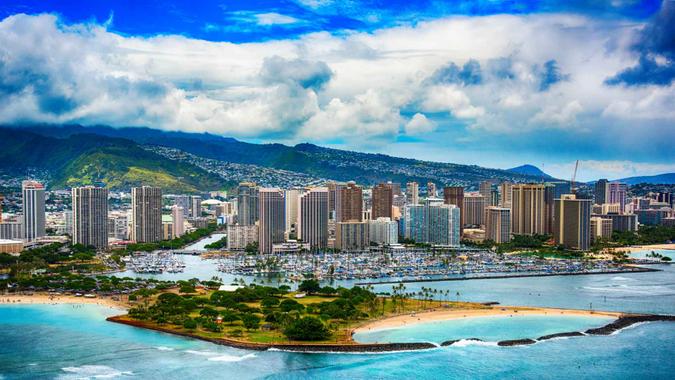
1. Hawaii
- Cost-of-living index: 182.3
- Annual expenditures: $165,304
- % of annual expenditures that $100K covers: 60.5%
Hawaii’s cost-of-living index is by far the nation’s highest, with $100,000 salary covering just over 60% of annual expenditures. The Aloha State has the highest grocery expenses ($791 a month). The housing index is a whopping 292.1, nearly three times the national median. Utilities and transportation are also the country’s highest. Healthcare costs trail only Alaska and Massachusetts.
Methodology: For this analysis, GOBankingRates first sourced the national average annual expenditures for people with incomes between $100,000 and $149,999 from the Bureau of Labor Statistics’ 2023 Consumer Expenditure Survey data. GBR then created state-level annual expenditure estimates by multiplying the national figure by each state’s cost-of-living index for Q1 2025 from the Missouri Economic Research and Information Center. Finally, GBR determined what percentage of annual expenditures is covered by $100,000 by dividing $100,000 by each state’s average annual expenditures estimate. All data was collected on and is up to date as of July 29, 2025.
More From GOBankingRates
This article originally appeared on GOBankingRates.com: How Far a $100K Salary Will Go in Every State

